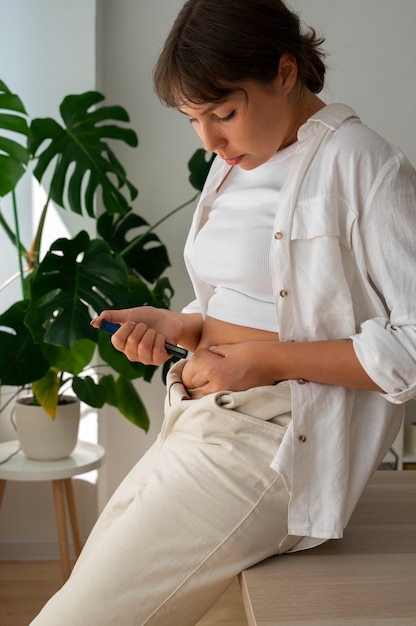
High blood sugar has become a widespread health concern, mostly due to unhealthy lifestyle habits adopted by many people around the world. If left unchecked, it can lead to diabetes, a lifelong condition that requires constant management. While medications are available to help lower and control blood sugar levels, it’s often a good idea to try natural approaches first. Making healthy lifestyle changes can be a more sustainable way to lower blood sugar and maintain it at healthy levels over time.
High blood sugar happens when the body isn’t able to efficiently manage the sugar in the bloodstream. This can lead to sugar levels rising, which, if ignored, could cause serious health issues. Research shows that a large percentage of adults worldwide are affected by conditions related to high blood sugar, and this number is steadily growing each year. The good news is that in many cases, high blood sugar can be managed at home with simple adjustments to daily habits and routines.
In cases where blood sugar levels become dangerously high, administering fast-acting insulin can provide quick relief. However, natural methods such as exercise, maintaining a healthy weight, and dietary adjustments can also play a big role in keeping blood sugar under control. On the other hand, people experiencing severe complications like Diabetic Ketoacidosis (DKA)—a serious condition often linked to type 1 diabetes—should seek immediate medical care.
### Blood Sugar Level Insights
Understanding where your blood sugar levels fall is key to knowing how to manage them. Here’s a quick breakdown:
– **Less than 100 mg/dL:** This could indicate low blood sugar, and you might need a small snack, like fruit or juice, to bring it back to a safe range.
– **100-160 mg/dL:** This is considered a healthy range and typically doesn’t require action.
– **180-250 mg/dL:** This level suggests you’re edging toward danger. Taking steps to lower it, especially if you’re not planning to exercise immediately, is important.
– **250 mg/dL or higher:** At this point, checking your urine for ketones is recommended. If ketones are present, contact a doctor right away.
Always consult your doctor about your specific blood sugar goals, as these might vary based on your health status.
### 11 Natural Ways to Lower Blood Sugar
1. **Cut Back on Carbs**
Reducing your carbohydrate intake can help a lot because carbs break down into sugar, which raises blood sugar levels. Stick to a low-carb meal plan to avoid putting extra strain on your insulin levels. Tracking your carb intake can help you manage meals and prevent sugar spikes.
2. **Stay Hydrated**
Drinking plenty of water is essential for controlling blood sugar. When you’re well-hydrated, your kidneys can flush out excess sugar through urine more effectively. Make sure to stick to water and unsweetened beverages, as sugary drinks can make things worse.
3. **Add Cinnamon to Your Diet**
Cinnamon can improve insulin sensitivity and slow the breakdown of carbs, which helps prevent sugar spikes after meals. Just 1-6 grams a day can make a big difference. However, don’t overdo it, as too much cinnamon can cause harm.
4. **Use Apple Cider Vinegar**
Apple cider vinegar (ACV) helps improve insulin sensitivity and lower fasting blood sugar levels. You can mix a couple of teaspoons into a glass of water or add it to salads. If you’re on medication, consult your doctor before adding ACV to your diet.
5. **Choose Low-GI Foods**
Low glycemic index (GI) foods are easier on your blood sugar. They take longer to digest and cause smaller sugar spikes. Foods like eggs, seafood, sweet potatoes, beans, and non-starchy vegetables are great options.
6. **Watch Your Portion Sizes**
Eating large portions increases both your calorie intake and blood sugar levels. To manage portion sizes, you can use smaller plates, check food labels, or eat slowly to feel full faster.
7. **Increase Fiber Intake**
Fiber slows down how quickly your body absorbs sugar, which helps prevent spikes. Soluble fiber, in particular, is highly effective in managing blood sugar. Foods like whole grains, fruits, vegetables, and legumes are excellent sources of fiber.
8. **Exercise Regularly**
Physical activity can quickly lower blood sugar by increasing insulin sensitivity. It also helps you burn off sugar for energy. Try walking, jogging, swimming, or strength training to reap the benefits.
9. **Manage Stress Effectively**
Stress triggers hormones like cortisol that can raise blood sugar. Techniques like yoga, meditation, and mindfulness can help keep stress at bay. Exercise is another great way to manage stress and lower blood sugar simultaneously.
10. **Get Quality Sleep**
Poor sleep is linked to higher blood sugar levels and weight gain. Aim for 7-8 hours of quality sleep every night to support overall health and avoid late-night cravings.
11. **Monitor Your Blood Sugar Daily**
Keeping track of your blood sugar levels helps you understand what’s working and what’s not. It also enables you to make quick adjustments to your diet or routine when your levels fluctuate.
### When to See a Doctor
If you’ve recently been diagnosed with type 2 diabetes or are experiencing symptoms like frequent urination, extreme thirst, stomach pain, nausea, or numbness in the hands and feet, it’s time to consult a doctor. Blood sugar consistently at 250 mg/dL or above is also cause for immediate medical attention. An endocrinologist, a doctor specializing in diabetes care, can provide the tailored advice and treatment you need.
By incorporating these natural strategies into your daily routine, you can successfully manage and lower high blood sugar at home. However, don’t hesitate to seek professional help if your condition doesn’t improve or if complications arise.